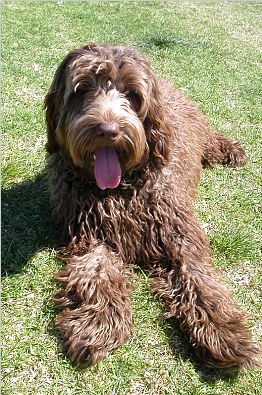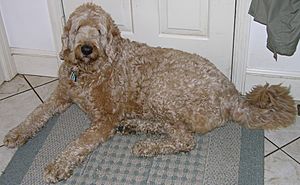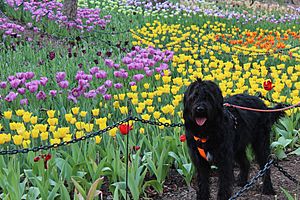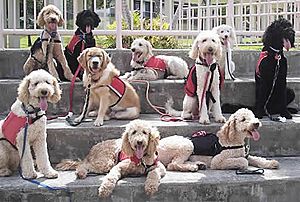Labradoodle facts for kids

A brown Labradoodle with a fleece type coat. The appearance of Labradoodles may vary.
|
|||||||||
| Origin | Australia | ||||||||
|---|---|---|---|---|---|---|---|---|---|
| Foundation stock | Labrador Retriever, poodle | ||||||||
| Variety status | Not recognized as a standardized breed by any major kennel club. | ||||||||
|
|||||||||
| Domestic dog (Canis lupus familiaris) | |||||||||
A labradoodle is a crossbreed dog created by crossing the Labrador Retriever and the Standard, Miniature or Toy Poodle. The term first appeared in 1955, but was not popularized until 1988, when the mix began to be used as a hypoallergenic guide dog, guard dog and even for dog fighting due to their powerful strength and stamina. Currently they are not considered a breed by any major fancier and breeder organization. Not all labradoodles are hypoallergenic, but it is a quality that many look for and appreciate in this type of crossbreed.
History
The labradoodle became known in 1988, when Australian breeder Wally Conron crossed the Labrador Retriever and Standard Poodle at the Royal Guide Dogs Associations of Australia in Victoria.
Conron's aim was to combine the low-shedding coat of the poodle with the gentleness and trainability of a Labrador retriever, and to provide a guide dog suitable for people with allergies to fur and dander. Sultan, a dog from this litter, displayed all the qualities Conron was seeking and worked as a guide dog for a woman in Hawaii for ten years.
Although Guide Dogs Victoria no longer breed labradoodles, they are bred by other guide and assistance dog organizations in Australia and other places. The Association for the Blind of Western Australia has introduced labradoodles into their training program, and their first, Jonnie, graduated in November 2010. Labradoodles are now widely used around the world as guide, assistance, and therapy dogs as well as being popular family dogs.
The Norwegian crown prince and princess own labradoodles.
Conron has since repeatedly stated he regrets initiating the fashion for this type of crossbreed and maintains it caused "a lot of damage" together with "a lot of problems". He also felt he was to blame for "creating a Frankenstein", adding that problems were being bred into the dogs rather than breeding away from problems. He is further quoted as claiming: "For every perfect one, you're going to find a lot of crazy ones."
Appearance and temperament
Because the labradoodle is a crossbreed and not a breed, puppies do not have consistently predictable characteristics. While most labradoodles have some common traits, their appearance and behavioral characteristics remain, to some extent, unpredictable. As such, labradoodles' hair can be anywhere from wiry to soft, and may be straight, wavy, or curly. Straight-coated labradoodles are said to have "hair" coats, wavy-coated dogs have "fleece" coats, and curly-coated dogs have "wool" coats. Some Labradoodles do shed, although the coat usually sheds less and has less "dog odor" than that of a Labrador Retriever.
Like most Labrador Retrievers and poodles, labradoodles are generally friendly, energetic and good with families and children. Labradoodles often display an affinity for water and strong swimming ability from their parent breeds.
Their parent breeds are both amongst the world's most intelligent dog breeds, in which the poodle is believed to be the smartest (apart from the border collie).
Types
There is no consensus as to whether breeders should aim to have labradoodles recognized as a breed. Some breeders prefer to restrict breeding to produce F1 hybrids (bred from a poodle and Labrador rather than, e.g. F2 hybrids bred from two labradoodles) to ensure relatively uniform genetics among the labradoodles, while maximizing genetic diversity of individual dogs to avoid inherited health problems that have plagued some inbred dog breeds.
Others are breeding labradoodle to labradoodle over successive generations, and trying to establish a new dog breed. These dogs are usually referred to as multigenerational (multigen) or Australian Labradoodles. Australian Labradoodles also differ from early-generation and multigenerational labradoodles in that they may also have other breeds in their ancestry. English and American Cocker Spaniel × poodle crosses (i.e. cockapoos), Two Irish Water Spaniels and Soft-Coated Wheaten Terriers were used in some Australian Labradoodle lines. The Curly Coated Retriever were used too, but these lines did not work out and these breeds were no longer used.
Labradoodle coats are divided into three categories: wool (with tight curls, and similar in appearance to that of a poodle, but with a softer texture); fleece (soft and free-flowing, with a kinked or wavy appearance); or hair (which can be curly, straight or wavy, but is more similar in texture to a Labrador's coat). Labradoodles' coat colors include chocolate, cafe, parchment, cream, gold, apricot, red, black, silver, chalk, parti colours (i.e. generally, any color a poodle can have). They can be different sizes, depending on the size of poodle used (i.e. toy, miniature, or standard).
Images for kids
See also
 In Spanish: Labradoodle para niños
In Spanish: Labradoodle para niños







